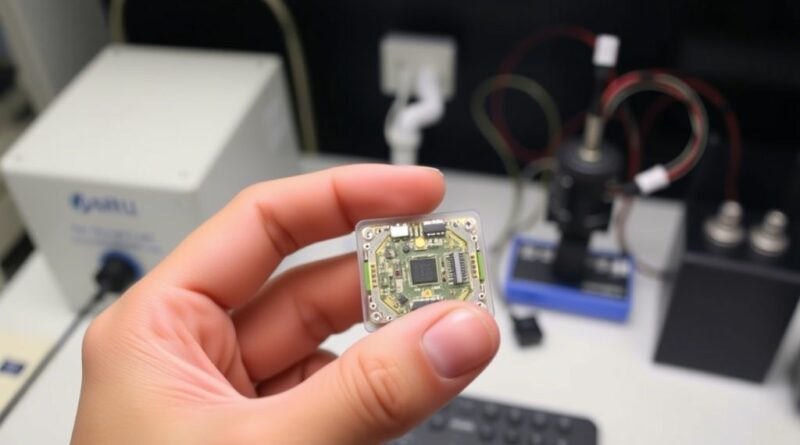Taiwan Develops the World’s Smallest Quantum Computer
In a groundbreaking achievement that could redefine the future of computing, researchers at Taiwan’s National Tsing Hua University (NTHU) have unveiled the world’s smallest quantum computer—a device so compact it operates using a single photon. This miniature marvel is not only rewriting the rules of what we thought possible in quantum technology but also paving the way for revolutionary advancements across industries as diverse as artificial intelligence, healthcare, cybersecurity, and logistics.
A Quantum Leap in Miniaturization
Quantum computers are no strangers to headlines, but they’ve long been associated with massive, complex machines requiring extreme conditions to function. Traditional quantum systems often rely on supercooled environments—operating near absolute zero temperatures—to stabilize their delicate qubits. These requirements make them expensive, energy-intensive, and impractical for widespread use.
But NTHU’s latest innovation flips this paradigm on its head. Their new quantum computer eliminates the need for bulky cooling systems entirely, operating seamlessly at room temperature. By encoding information into 32 dimensions within a single photon, this ultra-compact design achieves computational power previously thought unattainable in such a small package.
“This isn’t just about shrinking the size of a quantum computer,” said Dr. Lin Wei-Cheng, lead researcher on the project. “It’s about making quantum computing accessible, efficient, and versatile enough to tackle real-world problems.”
What Makes It Revolutionary?
1. Ultra-Compact Design
The most striking feature of this quantum computer is its diminutive size. Unlike conventional quantum processors, which require vast spaces filled with cryogenic chambers and intricate wiring, this device fits comfortably within the palm of your hand. Its ability to operate without specialized cooling infrastructure opens up possibilities for portable quantum devices, bringing us closer to a future where supercomputers might fit in our pockets.
2. Mind-Blowing Power
Despite its tiny frame, the computer packs an impressive punch. By leveraging advanced photonic technologies, it encodes data across 32 dimensions within a single photon. This multidimensional approach allows it to process vast amounts of information simultaneously, far exceeding the capabilities of classical binary systems. Imagine solving complex mathematical equations or simulating molecular interactions at speeds previously unimaginable—all powered by light itself!
3. Future-Ready Applications
The implications of this breakthrough extend far beyond theoretical physics. Here are just a few areas set to benefit from this transformative technology:
- Artificial Intelligence (AI): Enhanced processing power means faster training times for machine learning models, enabling smarter AI applications in everything from autonomous vehicles to personalized medicine.
- Drug Development: Simulating chemical reactions at the quantum level will accelerate drug discovery processes, potentially leading to life-saving treatments for diseases like cancer and Alzheimer’s.
- Data Security: With quantum encryption protocols, sensitive information can be safeguarded against even the most sophisticated cyberattacks, ensuring privacy in an increasingly digital world.
- Logistics Optimization: Complex supply chain challenges, such as route planning and inventory management, can be solved more efficiently, reducing costs and improving service delivery.
The Dawn of a New Era
This development marks a significant milestone in the evolution of quantum computing. For decades, scientists have dreamed of harnessing the principles of quantum mechanics to create machines capable of outperforming classical computers. While previous attempts have focused on scaling up existing architectures, NTHU’s team took a different path—scaling down instead.
“By focusing on simplicity and efficiency, we’ve demonstrated that big things really do come in small packages,” explained Professor Chen Mei-Ling, co-author of the study. “Our goal was to build something practical, scalable, and adaptable to various applications.”
As interest in quantum technologies continues to grow globally, Taiwan positions itself as a leader in this emerging field. This achievement underscores the country’s commitment to fostering innovation and pushing the boundaries of scientific exploration.
Can You Imagine the Possibilities?
Picture a world where quantum computers are no longer confined to high-security labs or research institutions. Instead, they become everyday tools, empowering individuals and businesses alike to solve problems once deemed insurmountable. From predicting weather patterns with pinpoint accuracy to designing sustainable energy solutions, the potential uses seem limitless.
While there’s still much work to be done before these pocket-sized powerhouses reach mass production, one thing is clear: the era of quantum computing has arrived—and it’s smaller than ever imagined.
So next time you hear someone say, “Good things come in small packages,” remember—the phrase now applies to some of humanity’s greatest technological achievements. Thanks to pioneering efforts like those at NTHU, the future of computing looks brighter—and tinier—than ever before.



